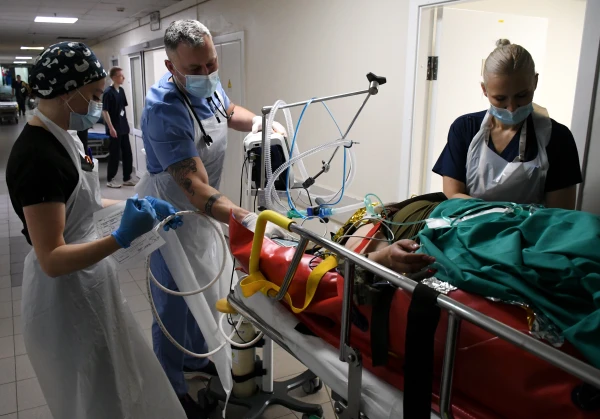
But one should not get sick, especially at a time when the government in the EU and NATO has made the infamous political decision – not to increase any expenditures except military ones. That is, prices for everything will continue to rise, while allocations for healthcare will remain the same. The only thing left is to look for internal resources.
And so the State Audit Office is conducting an audit in institutions under the Ministry of Health. The results have turned out to be quite unpleasant for the agency of Hosam Abu Meri ("New Unity").
"No Reforms, Staff Shortages..."
This is already stated in the title of the information material presented by State Audit Council member Maija Aboline to the Saeima Commission on Public Expenditures and Audits. Over the year, the budget allocates about 700 million euros to hospitals in Latvia, or 40% of healthcare expenditures. Just for the emergency rooms of hospitals – 100 million.
On the map of Latvia, there is one large dot with a Roman V – three level 5 hospitals are concentrated in Riga: Eastern Clinical (Gailesers), Stradins, and the Children's Hospital.
There are also six level 4 hospitals in the republic. The rest is just minor. A dressing can still be done, but a simple operation is unlikely. For example, when my acquaintance hooked his finger while fishing in Kraslava, it was only possible to extract it under anesthesia in Daugavpils...
Nevertheless, about 300,000 hospitalizations occur in the country each year – that is, on average, every sixth Latvian is treated in a hospital.
As noted, the lion's share falls on the largest level 5 hospitals (43% of patients), followed by level IV (27%), level III (10%), level II (3%), and level I (2%). It is clear that in the conditions of Kurzeme, for example, one has to measure dozens of kilometers to the nearest serious hospitals in Liepaja or Ventspils. And the requirements for hospitals, according to the State Audit Office, are: "A beautiful building. Modern equipment. Close to home. Skilled staff."
Meanwhile, in Latvia, even emergency departments are not available in all hospitals – they have been eliminated in 5 out of 41. The State Audit Office states: "Patients do not have equal opportunities to receive quality healthcare services. In hospitals of the same level, the basket of services and quality differ. There is a shortage of medical staff in emergency departments."
What is DRG
Your author became acquainted with this mysterious abbreviation while studying the audit table, where this set of letters occupies the 1st place among the expenses of all hospitals (43%), and a large part in level 5 hospitals (51%).
"The Diagnosis-Related Group (DRG) system, – explains the National Health Service website, – is an internationally recognized tool for organizing the healthcare system, providing a common understanding of medical services for both healthcare professionals and financial specialists. The DRG system is used for accounting, payment, and analysis of medical services provided to patients in a hospital setting."
Under the DRG system, the state pays hospitals in 16 different ways. The State Audit Office states: "The rates have not been updated for a long time, as their 'formulas' do not correspond to the financial situation. Continuous funding adjustments throughout the year and an opaque process for their redistribution."
Separately, across all hospitals in Latvia – payment for designated services (19%), payment for emergency medicine and emergency department operations (14%), payment for patient observation for 24 hours (2%), payment for other services (22%). The lower the level of the hospital, the higher the share of emergency services – for example, at level I it is 48%.
By the way, just in case, it was calculated what would happen if emergency departments were eliminated altogether at levels I and II – that would save 12.5 million euros a year.
The National Medical Authority formally has external control – the Health Inspectorate. However, as the State Audit Office states, the results of its inspections have not been taken into account... since 2019! That is, even before the COVID madness and the military-sanction period. And with the proposals from the World Bank, which also inspects hospitals in Latvia, the situation is even worse – they have been ignored since 2016.
Changes Will Come, But by 2029
Such a timeline for the introduction of five major improvements has been set for the Ministry of Health by the State Audit Office. So, in 4 years in Latvia:
"In an orderly network of hospitals, patients will have equal opportunities to receive quality hospital services. Hospitals will receive fair payment for quality services. Reprofile and oversee the hospital network. Optimize and oversee the network of emergency departments. Introduce quality indicators and link them to financing. Update rates and improve the DRG system."
For its part, the Ministry of Health presented to the parliamentary commission... the experience of colleagues. In Estonia, for example, the number of hospitals has been reduced to 17. That is, 41% of the number of such hospitals in our republic, while the population of the neighboring country is 69% of Latvia. One can only envy the concentration of medical capital among the Estonians, especially since hospitals there now operate in a 24/7 mode.
Lithuania, on the other hand, has set the task of ensuring delivery to hospitals within 60 minutes from any place of residence in the country: "The range of outpatient services is expanding, family doctor teams are being strengthened, and day hospitals are being developed to reduce unnecessary hospitalizations and promote care closer to home."
Outpatient health centers in the neighboring republic are subordinate to municipalities. By the way, there is also a wonderful first city hospital in Riga, with ancient traditions, in the very center of the capital – but our mayor, Viesturs Kleinbergs, despite being from the "Progressive" party, is in no hurry to help this unique medical institution. This is a capital society of self-government, managed by executive director Janis Lange...
And there is also the path of Austria, which has completely transferred part of its outpatient services... to a digital format. That is, instead of going to see a doctor, patients now communicate with the doctor online. In Latvia, this is called "telemedicine."
But still, in the near future, local hospitals will remain. And they will even provide an emergency department – an internist, a surgeon, an on-call doctor; inpatient care – therapy and chronic diseases; day hospital – short-term surgery; outpatient part. Although in the future, small hospitals may possibly become part of the "ecosystems" of university hospitals – a discussion is expected here...
Not Enough Funding
_In 2025, according to the State Audit Office, as a result of "internal injustice" by the Ministry of Health, the Eastern Hospital (Gailesers) will be short of funding by 12.7 million euros; Stradins – 6.8 million euros.
















Leave a comment